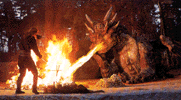Spotlight : December 1996
Photorealism?
by Owen Hammer
Spotlight : December 1996
Photorealism?
by Owen Hammer
With "'net" (as in internet), "video" (as in music video), and "cyberspace" (as in
whatever the media is calling it this week) appearing in dictionaries, you'd think
that the visual effects term "photorealism" would be appearing in dictionaries by now.
"Photo-" as a suffix (having to do with photography) and "realism" (usually three or
so different definitions) are standard, so I suppose the dictionary publishers assume
that this fulfills their responsibility.
I have little information regarding the etymology of the word, but I'd imagine it
evolved from the need for effects houses to advertise using an intuitively graspable
word differentiating them from the low end companies.
"Of course we can, we here at Flooblevision pride ourselves on the highest quality
visual effects."
"But are they photorealistic?"
"Er, uh, well I mean uh, . . . no."
"Then I will take my business elsewhere."
"Curse you advertising agency executive, you're too smart for me."
Apparently photorealism is the highest quality of effects work. A taxonomy might look
like this:
I have yet to see "Flooblevision gives you images better than photorealistic."
But I still need a defition for photorealism -- Something like:
This explains the 'photo-' prefix, but there's a major flaw in this definition. We
never have a photograph of the event, so we don't know for sure. After all, if you
could actually photograph the event, 99% of the time, you would do that. Conversely,
99% of the scenarios in effects shots are things you could never realistically
photograph.
In other words, "realism," is synonymous with "non-artificiality." The good thing
about this definition is that it avoids having to define what reality is, which is not
my goal. The bad thing about it is that "evidence of artificiality" is an equally
nebulous concept.
Now the definiton is becoming too unweildy. Furthermore it's still not comprehensive.
What about DRAGONHEART? Surely there can be no
such thing as a photorealistic dragon. No photos exist of dragons, because no such
thing exists. There's no good frame of reference either. In JURASSIC PARK, Dennis
Muren had fossil records and paleontological evidence, as well as the behavior of
modern day lizards from which to extrapolate a model of a real (hence photorealistic)
dinosaur. There's no such thing as a winged, quadruped with scales, and thus no one
model for a Dragon. The creature is an amalgam of the artists knowledge of various
animals.
Draco the Dragon does look very convincing, though, for exactly that reason. The
little bobbing and fluttering of him flying reminds us of our knowledge of birds, his
walking reminds us of quadrupeds, and his talking and hand gestures remind us of
humans. Everything else is an educated guess. So why can't we say:
Effects are built around our own understanding of the physical world. Like all art,
they deal with the subjective -- with idioms. Often they are effective because they
demonstrate to us how broad our understanding is. We are excited at our own ability
to understand these things, even though our rational mind tells us that they are not
true. So when we say "that looked real," we mean "I previously did not know that my
comprehension of existence was so encompassing as to understand the inherent successes
and flaws of that partial representation of the physical world."
So to avoid continued verbosity:
Unfortunately, this definition falls short as well. In the late 1980's, In Saudi
Arabia and other Arab countries a series of interchangably unoriginal actions films
were made. These films all involved the most hated man in the Muslim world: Salman
Rushdie. In the movies, Rushdie would live in luxurious palace and torture Arabs for
sport. The main characters would be an elite group of government authorized Arab
mercenaries who would hunt him down. In the end, the mercenaries corner him, but
through trickery, Rushdie defeats them. Then, before the leader is killed, the
heavens open and bursts of holy energy crackle and incinerate Rushdie.
Okay, I unfortunately have no GIFs of any of the four films I have heard of where this
ending occurs, but I have seen them, and I believe that the effect was simple
scratches on the negative -- fingernails scratched on the emulsion on the film. Now
is this 'photorealistic?' Well according the definition I have drawn up, it is!
After all the audiences this film was designed for believe in divine retribution, but
no one had a photograph of it, so anyone's attempt at 'photorealism' was as good as
anyone elses. The scratches don't look like lightning, but who said we're talking
about lightning, it's some previously unidentified form of energy, it looks fake and
the audience's concept of reality was never contradicted.
The effect is not photorealistic, so logically I must discard that definition as well
as any definition which tries to take into account cultural standards.
I thus find myself with:
Anyone with a better guess is encouraged to e-mail me.
"Yes, we're doing a commercial, and I saw on the Discovery Channel that visual effects
are hot. Can your company provide me with some?"
-- George
Méliès
-- "Land of the Lost"
-- "Star Trek" (1960's)
-- "V: The Mini-Series"
-- "V: The Series"
-- "Star Trek" (1990's)
-- Photorealism
Photorealism: FOE'TO-REE'UH-LIZ'UHM (n)
The highest level of quality of a graphic such that it is identical to a
photograph.
 Look at Tom Cruise in MISSION: IMPOSSIBLE. People
would say that the shot of Cruise flying out of the helicopter, and onto the train
looks real. They might even mention that it looked real the first seventeen times in
the trailer, and still looks real the eighteenth time they saw it in the actual film.
Anyway, having never witnessed such a thing, how can we say that it looks real? What
we mean to say is that we can find no flaw in the effect such that it gives itself
away as an effect (as opposed to actual film of Cruise flying off of an exploding
helicopter, which would last for a short period of time, as Cruise's body goes up in
flames). So my definiton has to encapsulate these assumptions:
Look at Tom Cruise in MISSION: IMPOSSIBLE. People
would say that the shot of Cruise flying out of the helicopter, and onto the train
looks real. They might even mention that it looked real the first seventeen times in
the trailer, and still looks real the eighteenth time they saw it in the actual film.
Anyway, having never witnessed such a thing, how can we say that it looks real? What
we mean to say is that we can find no flaw in the effect such that it gives itself
away as an effect (as opposed to actual film of Cruise flying off of an exploding
helicopter, which would last for a short period of time, as Cruise's body goes up in
flames). So my definiton has to encapsulate these assumptions:
Photorealism: FOE'TO-REE'UH-LIZ'UHM (n)
The highest level of quality of a visual effect such that no evidence of
its artificiality is visible.
 Take a look at SPEED. When the bus drives right of off
the ramp, and onto the other side, it looks real; but how is that possible when it has
just broken two of Newton's laws of motion (even if the bus was traveling at light
speed, it couldn't do that). In a 'photorealistic' shot, the bus would crash into the
lip of ramp, and the rest of the movie would be seventy minutes of Dennis Hopper
laughing. I suppose an accurate definition would be:
Take a look at SPEED. When the bus drives right of off
the ramp, and onto the other side, it looks real; but how is that possible when it has
just broken two of Newton's laws of motion (even if the bus was traveling at light
speed, it couldn't do that). In a 'photorealistic' shot, the bus would crash into the
lip of ramp, and the rest of the movie would be seventy minutes of Dennis Hopper
laughing. I suppose an accurate definition would be:
Photorealism: FOE'TO-REE'UH-LIZ'UHM (n)
The highest level of quality of a visual effect such that no evidence of
its contradiction of the laws of physics are visible, when no such contradictions
exist in the narrative.

Photorealism: FOE'TO-REE'UH-LIZ'UHM (n)
The highest level of quality of a visual effect such that all physical
phenomonae conform to the audience's frame of reference for similar or identical
phenomona.
 Well it's certainly a broad definition, but it is accurate. Look at The THE FRIGHTENERS. Everybody has their own concept of
Heaven, Hell, and ghosts. But the ghosts sometimes obey our laws of physics, when the
stand on the ground, but disobey them when they walk through walls. We accept this,
because it conforms to our understanding of semi-transparent refractive substances,
light, fluids, rigid objects, colloids, human motion, and thus looks 'real' shifting
between them even though no such thing could happen. When people think about the
concept of a human being intangible, they think about walking through walls. Nobody
thinks about just sinking into the ground, or flying off into space when gravity and
inertia no longer have any control over you.
Well it's certainly a broad definition, but it is accurate. Look at The THE FRIGHTENERS. Everybody has their own concept of
Heaven, Hell, and ghosts. But the ghosts sometimes obey our laws of physics, when the
stand on the ground, but disobey them when they walk through walls. We accept this,
because it conforms to our understanding of semi-transparent refractive substances,
light, fluids, rigid objects, colloids, human motion, and thus looks 'real' shifting
between them even though no such thing could happen. When people think about the
concept of a human being intangible, they think about walking through walls. Nobody
thinks about just sinking into the ground, or flying off into space when gravity and
inertia no longer have any control over you.
Photorealism: FOE'TO-REE'UH-LIZ'UHM (n)
The highest level of quality of a visual effect wherein the audience's
concept of reality is never contradicted.
Photorealism: FOE'TO-REE'UH-LIZ'UHM (n)
The unquantified highest level of quality of a visual effect.
Owen Hammer
Back to the Spotlight Main Menu

. . VFX HQ Produced by Todd Vaziri . . http://www.vfxhq.com . . e-mail: tvaziri@gmail.com . .
All text Copyright © 1998 Todd Vaziri, unless otherwise noted